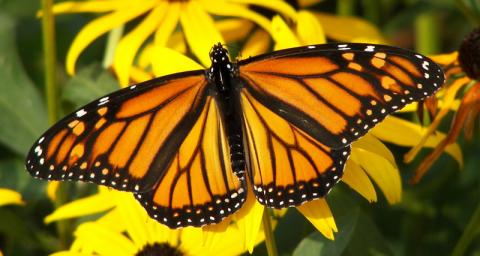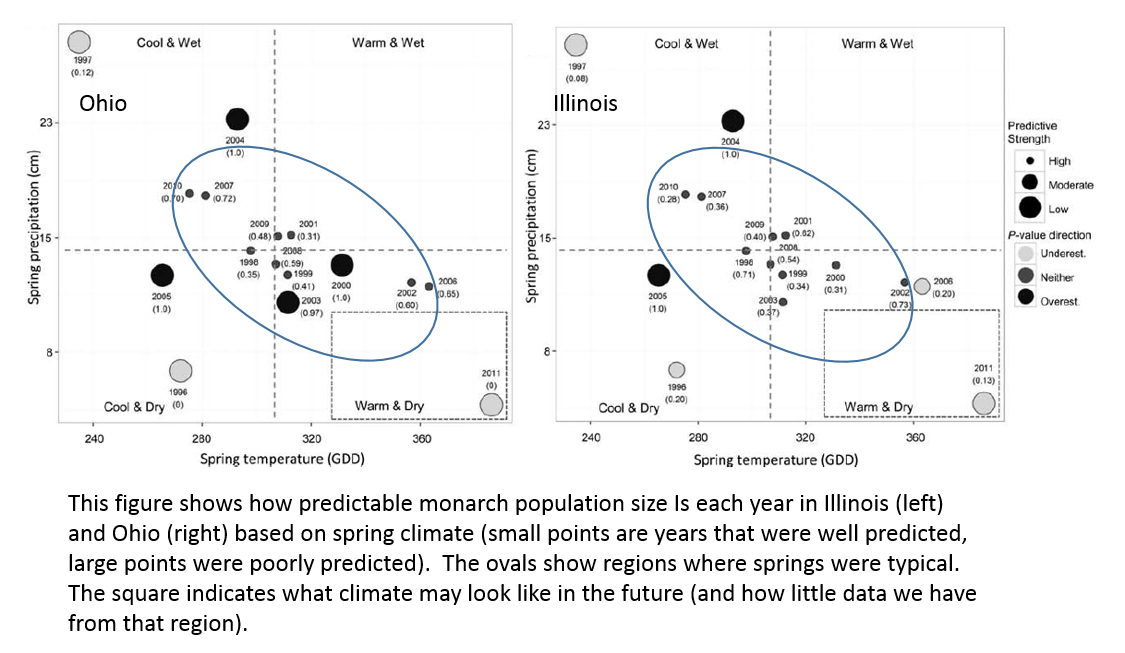Research Snapshot: Monarch responses to climate
Monarchs populations show dramatic fluctuations from year to year and we have been working to pinpoint the causes of these fluctuations. Our research suggests that conditions in both the spring and summer have an impact on how large the monarch population gets each summer, but that spring conditions seem to be more important.
Our research to date has relied on two data sets from long-term monitoring programs. Using Illinois and Ohio data, we have shown that monarch population dynamics are largely driven by spring climate (Zipkin et al. 2012, Saunders et al. 2016) and, further, that population size is highly predictable based on climate as long as that year’s spring was within a “typical” (average) climate window (Saunders et al. 2016). However, for atypical springs, it is very difficult to predict population responses which calls into question our ability to predict into future climates that may be very different from what is being experienced today.
Details
Publications
Saunders, S.P., L. Ries, N. Neupane, M. I. Ramirez, E.Garcia-Serrano, E. Rendon-Salinas, E.F. Zipkin. 2019. Multi-scale seasonal factors drive the size of winter monarch colonies. Proceedings of the National Academy of Sciences. 201805114
Ries, L., E. Zipkin, R. Guralnick. 2019. Tracking trends in monarch abundance over the 20th century is currently impossible using museum records. Proceedings of the National Academy of Sciences Jul 2019, 116 (28) 13745-13748; DOI: 10.1073/pnas.1904807116
Ries, L., N. Neupane, K. A. Baum, E. F. Zipkin. (2018). Flying through hurricane central: impacts of hurricanes on migrants with a focus on monarch butterflies. Animal Migration 5(1): 94-103..
Saunders, S., L. Ries, K. Oberhauser, W. Thogmartin, E. Zipkin. 2018. Local and cross-seasonal effects of climate and land-use on migratory monarch butterflies. Ecography. 41 (2), 278-290
Oberhauser, K., R. Wiederholt, J. E. Diffendorfer, D. Semmens, L. Ries, W. E. Thogmartin, L.A. Lopez‐Hoffman, B. Semmens. 2017. A trans‐national monarch butterfly population model and implications for regional conservation priorities. Ecological Entomology, 42(1), 51-60.
Saunders, S.P., L. Ries, K.S. Oberhauser, and E.F. Zipkin. 2016. Evaluating confidence in population-level predictions from climate impacts: Summer abundances of the monarch butterfly. Global Ecology and Biogeography 25:1000-1012.
Ries, L., E. Rendon and D. Taron. 2015. The disconnect between summer and winter monarch trends for the Eastern migratory population: possible links to differing drivers. Invited paper in Annals of the Entomological Society of America (Online early).
Ries, L., K. Oberhauser, D. Taron, E. Rendon-Salinas. 2015. Connecting eastern monarch population dynamics across their migratory cycle. Invited book chapter in (K. Oberhauser, ed.) Monarchs in a changing world: Biology and conservation of an iconic butterfly. Cornell University Press. Ithaca, NY.
Zipkin, E. F., L. Ries, R. Reeves, J. Regetz and K. S. Oberhauser. 2012. Tracking climate impacts on the migratory monarch butterfly. Global Change Biology 18:3039-3049
 The Ries Lab of Butterfly Informatics
The Ries Lab of Butterfly Informatics
